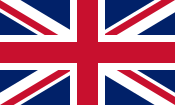 | |
| Union Flag, Union Jack, British flag, UK flag | |
| Use | National flag |
|---|---|
| Proportion | 1:2 |
| Adopted | 1 January 1801 |
| Design | A white-fimbriated symmetric red cross on a blue field with a white-fimbriated counterchanged saltire of red and white. |
| Alternative 3:5 ratio | |
 | |
| Proportion | 3:5 |
The national flag of the United Kingdom is the Union Jack, also known as the Union Flag.[a]
The design of the Union Jack dates back to the Act of Union 1801, which united the Kingdom of Great Britain and the Kingdom of Ireland (previously in personal union) to create the United Kingdom of Great Britain and Ireland. The flag consists of the red cross of Saint George (patron saint of England, which also represents Wales), edged in white, superimposed on the saltire of Saint Patrick (patron saint of Ireland), also edged in white, which are superimposed on the saltire of Saint Andrew (patron saint of Scotland). Wales is not represented in the Union Flag by Wales's patron saint, Saint David, because the flag was designed whilst Wales was part of the Kingdom of England.
The flag proportions on land and the war flag used by the British Army have the proportions 3:5.[10] The flag's height-to-length proportions at sea are 1:2.[11] The Union Flag also features in the canton of the flags of the Royal Navy, the Royal Air Force, and the British Merchant Navy. These flags are known as ensigns.
The earlier flag of Great Britain was established in 1606 by a proclamation of King James VI and I of Scotland and England.[12] The new flag of the United Kingdom was officially created by an Order in Council of 1801, with its blazon reading as follows:
The Union Flag shall be azure, the Crosses saltire of Saint Andrew and Saint Patrick quarterly per saltire, counter-changed, argent and gules, the latter fimbriated of the second, surmounted by the Cross of Saint George of the third fimbriated as the saltire.[13]
No official standardised colours were specified, although the Flag Institute defines the red and royal blue colours as Pantone 186 C (RGB 207, 20, 43) and Pantone 280 C (RGB 0, 36, 125), respectively.[14]
- ^ "The Union Jack or The Union Flag?". The Flag Institute. 20 June 2014. Archived from the original on 13 June 2013. Retrieved 3 December 2015.
- ^ The Lords Commissioners of the Admiralty (1911) [1908], Manual of Seamanship, vol. I, London: HMSO, p. 20
- ^ a b "-kin". Oxford English Dictionary (Online ed.). Oxford University Press. (Subscription or participating institution membership required.)
- ^ "John". Oxford English Dictionary.
- ^ a b c "Jack". Oxford English Dictionary.
- ^ "Jack". Oxford English Dictionary.
- ^ 1633 quotation cited in "Jack". Oxford English Dictionary.
- ^ "Union flag". Oxford English Dictionary (Online ed.). Oxford University Press. (Subscription or participating institution membership required.) "Compare slightly later Union Jack"
- ^ "jackstaff". Oxford English Dictionary (Online ed.). Oxford University Press. (Subscription or participating institution membership required.)
- ^ The Flag Institute Archived 10 September 2022 at the Wayback Machine It says "The proportions of the flag are 30 units wide by 50 units long", or in other words; the flag proportions are 3:5.
- ^ United Kingdom, flag of the Archived 17 May 2013 at the Wayback Machine, for flag ratio see flag caption
- ^ A.C. Fox-Davies, The Art of Heraldry: An Encyclopædia of Armory (1904, reprinted 1986, ISBN 0-906223-34-2), p. 399: "By the King: Whereas, some differences hath arisen between Our subjects of South and North Britaine travelling by Seas, about the bearing of their Flagges: For the avoiding of all contentions hereafter. We have, with the advice of our Council, ordered: That from henceforth all our Subjects of this Isle and Kingdome of Great Britaine, and all our members thereof, shall beare in their main-toppe the Red Crosse, commonly called St George's Crosse, and the White Crosse, commonly called St Andrew's Crosse, joyned together according to the forme made by our heralds, and sent by Us to our Admerall to be published to our Subjects: and in their fore-toppe our Subjects of South Britaine shall weare the Red Crosse onely as they were wont, and our Subjects of North Britaine in their fore-toppe the White Crosse onely as they were accustomed"|James VI and I|Orders in Council; Official creation of the Union Flag – 1606."
- ^ Max Cryer, Curious English Words and Phrases: The Truth Behind the Expressions We Use (2012), p. 395: "When Britain's official flag settled down in 1801, its exact design and colouring were meticulously written out by Order of Council which described it as 'the Union Flag'... The correct formal wording of the Order of Council, 1801, was..." &c.
- ^ "Union Flag: Specification". The Flag Institute. Archived from the original on 22 July 2024. Retrieved 4 September 2024.
Cite error: There are <ref group=lower-alpha> tags or {{efn}} templates on this page, but the references will not show without a {{reflist|group=lower-alpha}} template or {{notelist}} template (see the help page).